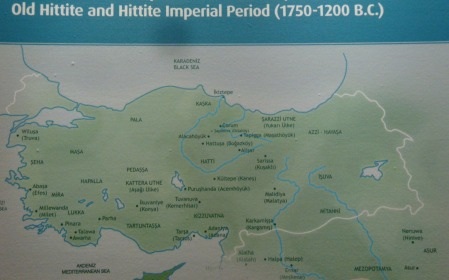Hard thought it is to believe it now, the very existence of the Hittites was forgotten for centuries. There were references to them in the Bible but in contexts that left it unclear who exactly they were. It was only in 1834 that the tireless French explorer, Charles Texier, stumbled upon the remains of Hattuşa, the city that was for centuries the capital of a Hittite Empire extending as far south as Lebanon and that is now one of Turkey’s UNESCO-listed World Heritage Sites.
Today, considerably more is known about the Hittites although much still remains unclear. They are now believed to have been a slave-owning Indo-European people who invaded Central Anatolia some time in the 18th century B.C. (the Bronze Age) and appear to have displaced the indigenous Hatti people whose name they seem to have taken for themselves. They left copious records inscribed in cuneiform on baked clay tablets, many of them rediscovered at Hattuşa, and worshipped a variety of deities including the Sun goddess, Arinna, and the Storm god, Tarhunna.
Their empire reached its greatest extent in the 14th century B.C. when Hattuşa was the Hittite capital and their territories included parts of modern Syria and Iraq. The Hittites even put up a challenge to the Egyptians although it was only time before they too met their match in the Phrygians (“Sea Peoples”) who swarmed in from Thrace c. 1180 BC and set up a rival capital at Gordion.
The Hittites were driven south where they created a series of Neo-Hittite city-states north and east of Adana. Some of these lived on into the seventh century B.C. before vanishing from the pages of history.
For visitors wanting to see the most impressive Hittite remains there are two particular areas on which to focus: the first around Çorum and Sungurlu, northeast of Ankara, and the second around Gaziantep. In 2011 a Hittite Trail linking some of the northerly sites was also mapped out (www.cultureroutesinturkey.com/c/hittite-trail/).
For detailed information on all Turkey’s Hittite sites pick up a copy of Anatolia: On the Trail of the Hittite Civilisation by Ali Kılıçkaya and Erdal Yazıcı. It’s on sale at Ankara’s Museum of Anatolian Civilisations where visitors can see many of the finds from Aslantepe, Karkamış, Alaca Höyük and Sakçagözü. The finds from Sam’al (Zincirli Höyük) are on display in the İstanbul Archaeological Museum.
Most important Hittite sites
İstanbul Archaeological Museum
Museum of Anatolian Civilisations, Ankara
Resuloğlu
Zincirli Höyük


